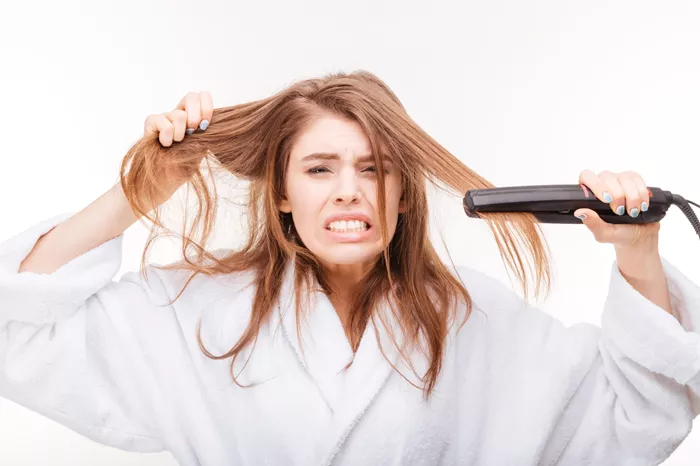Flat ironing is a popular method for achieving sleek, straight hair. However, many people encounter a common issue: frizz after flat ironing. This can be frustrating, especially after investing time and effort into styling. Understanding why frizz occurs and how to prevent it is crucial for maintaining smooth, polished hair. This comprehensive guide delves into the causes of post-flat ironing frizz and provides practical solutions to achieve flawless results.
The Science Behind Frizz
What is Frizz?
Frizz is a common hair issue characterized by unruly, flyaway strands that disrupt the smoothness of your hair. It occurs when hair strands absorb moisture from the air, causing them to swell and become uneven.
How Does Flat Ironing Affect Hair?
Flat irons work by applying heat to the hair, which changes the hair’s natural shape. While this heat can temporarily straighten hair, it can also damage the hair cuticle, the outer protective layer. Damaged cuticles can lead to increased moisture absorption and, consequently, frizz.
Common Causes of Frizz After Flat Ironing
Excessive Heat Exposure
Impact of High Heat
Using a flat iron at high temperatures can damage the hair cuticle, leading to increased porosity. Porous hair is more susceptible to moisture absorption from the environment, which can result in frizz.
Insufficient Heat Protection
Role of Heat Protectants
Heat protectant products create a barrier between your hair and the flat iron, reducing direct heat damage. Without proper protection, hair is more likely to become frizzy after styling.
Hair Porosity
Understanding Porosity
Hair porosity refers to the hair’s ability to absorb and retain moisture. Highly porous hair, which has cuticles that are raised or damaged, is more prone to frizz after flat ironing.
Environmental Factors
Humidity and Frizz
High humidity levels can cause hair to swell and frizz. Even after flat ironing, if the environment is humid, the hair can absorb moisture and lose its smoothness.
Product Build-Up
Effect of Hair Products
Using too many hair products or not properly cleansing your hair can lead to product build-up. This build-up can affect how well your hair responds to flat ironing, contributing to frizz.
Hair Health
Impact of Damaged Hair
Hair that is already damaged or over-processed is more likely to frizz. Flat ironing can exacerbate existing damage, making the frizz more pronounced.
How to Prevent and Manage Frizz After Flat Ironing
Choose the Right Flat Iron
Temperature Control
Opt for a flat iron with adjustable temperature settings. Use a lower heat setting for fine or damaged hair and a higher setting for thicker hair. Avoid using excessive heat, as this can cause more harm than good.
Use a Heat Protectant
Selecting a Heat Protectant
Apply a heat protectant spray or serum to your hair before flat ironing. This helps create a protective barrier and minimizes heat damage, reducing the likelihood of frizz.
Ensure Proper Hair Preparation
Prepping Your Hair
Before flat ironing, ensure your hair is clean and dry. Avoid flat ironing wet or damp hair, as this can cause damage and increase frizz. Use a gentle shampoo and conditioner to maintain hair health.
Maintain Hair Health
Regular Conditioning
Incorporate deep conditioning treatments into your hair care routine to keep your hair moisturized and healthy. Well-conditioned hair is less prone to frizz and better able to withstand styling.
Avoid Overuse of Heat Tools
Limiting Heat Exposure
Reduce the frequency of flat ironing and other heat styling to prevent damage. Allow your hair to recover between heat treatments by embracing its natural texture or using alternative styling methods.
Manage Environmental Factors
Dealing with Humidity
Use anti-frizz or anti-humidity products to help combat the effects of moisture in the air. These products can help seal the hair cuticle and reduce frizz caused by environmental factors.
See also: Best Anti-Frizz Spray in 2024: A Comprehensive Guide
Use Frizz-Control Products
Choosing the Right Products
Incorporate frizz-control products, such as smoothing serums or oils, into your hair care routine. These products can help tame frizz and maintain a sleek look.
Tips for Achieving a Smooth Finish
Section Your Hair
Flat Ironing in Sections
Divide your hair into manageable sections before flat ironing. This ensures even heat distribution and helps achieve a smoother finish.
Avoid Overlapping Passes
Efficient Flat Ironing
Pass the flat iron through each section of hair only once or twice. Overlapping passes can cause additional damage and increase the risk of frizz.
Finish with a Cool Blast
Setting the Style
After flat ironing, use a cool blast of air from a hair dryer to help set the style and seal the hair cuticle. This can help reduce frizz and enhance the smoothness of your hair.
Professional Advice and Treatments
Consulting a Hair Stylist
For personalized advice on managing frizz and maintaining healthy hair, consult a professional hair stylist. They can recommend specific products and techniques based on your hair type and condition.
Hair Treatments
Consider professional hair treatments, such as keratin treatments or salon conditioning services, to address frizz and improve hair health. These treatments can provide longer-lasting results and enhance the overall appearance of your hair.
Conclusion
Frizz after flat ironing can be a frustrating issue, but understanding its causes and implementing effective strategies can help you achieve smoother, shinier hair. By choosing the right flat iron, using heat protectants, maintaining hair health, and managing environmental factors, you can minimize frizz and enjoy the benefits of sleek, polished hair. Remember to adapt your hair care routine based on your hair type and condition, and consult professionals if needed to achieve the best results.


